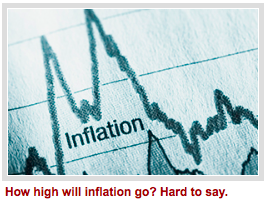
Quite a surprise when Gold fell into a bear market in reaction to the Fed’s 2011 QE III – the nearly unlimited money-printing blitz. A historical review tells us when we can expect inflation and another important underlying force that you need to understand….
Inflation?
The most frequently asked question I seem to get, even these days, is: “Larry, don’t you see hyperinflation for the U.S. in the years ahead?”
So let me clarify my position, here and now. There was a time when I expected the U.S. economy would eventually experience hyperinflation.
But when the price of gold failed to react to the Fed’s QE III announcement of virtually unlimited money-printing in September 2011 and the yellow metal entered a bear market, I knew something had radically changed.
So I further researched the known periods of hyperinflation in the world. And I found something that completely changed my view: There has never been a major core economy that has died at the hands of hyperinflation.
There was the Weimar Republic, of course, but it was not a core economy for the world. There are the hyperinflations of Zimbabwe, Brazil, Argentina, Venezuela now and countless other small economies that were never at the core of the global economy.
 And upon further study, I found that even the Roman Empire, certainly a core economy during its reign, didn’t even die of hyperinflation.
And upon further study, I found that even the Roman Empire, certainly a core economy during its reign, didn’t even die of hyperinflation.
It died largely because of abuse of power by politicians, which drove citizens away from the Empire; because of rapidly rising taxation, which had the same effect; and because of a corrupt treasury and justice system that tracked down and confiscated citizens’ wealth, largely to fund increased military campaigns, which were hoped to revive the Roman economy. Sound familiar?
Was there high inflation in Rome before it fell? Yes, but nothing of the sort of hyperinflation like we subsequently saw in Weimar Germany or any of the countries I mention above.
So, then, what does the U.S. economy face? Further disinflation, eventual reflation or something else?
My view, and I am not hedging my answer or talking out of both sides of my mouth: We face a combination of further disinflation in the short term, followed by a rather large jump in inflation a few years from now.
How high will inflation eventually go? Hard to say, but I wouldn’t be surprised if, say, three years from now, we see 20% or even 25% inflation for a very brief period of time.
But I highly doubt we will ever see inflation in the thousands or even millions of percent. It’s just not possible in a core economy. For many different reasons.
Whether we have deflation or inflation is also the wrong way to think about the U.S. economy these days. The reason? Ever since we abandoned the gold standard, inflation and deflation have become two sides of the same coin.
In other words, they are both present in the economy at the same time. You can have certain goods and services and even asset classes deflating, while others are inflating. It’s as simple as that.
For instance, the price of LED TVs has crashed in the past year or so, as have the prices of laptop computers and many other goods.
So it’s not a matter of one or the other, it’s a matter of what sector is inflating and why, versus which sectors are deflating and why.
Nevertheless, there’s another important underlying force that you need to understand, another one that resulted from the abolishment of the gold standard.
A certain level of general, system-wide inflation is always baked into the cake. It’s due, again, to the fact that we no longer have a gold standard, but it’s also due to many other forces, such as population growth, limited availability of natural resources, the constant desire for people to improve their lives and more.
This is important to understand, because it’s the chief reason prices will be higher a year from now, five years from now and even 10 years from now … no matter what the U.S. or global economy does.
And it’s also why investing in gold — just after it experiences a short-term disinflationary trend — is an ideal strategy to jump on.
Speaking of gold. It looks good now. But you don’t want to buy it at these levels. Gold’s new bull market is just getting started. Let it prove itself by first pulling back — which it will do, to below $1,200 …
Then back up the truck. Ditto for other precious metals and especially mining shares.
Best wishes,
Larry
related: Billionaire George Soros Cuts U.S. Stocks Position – Buys Barrick Gold













